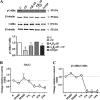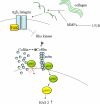Collagen fragments inhibit hyaluronan synthesis in skin fibroblasts in response to ultraviolet B (UVB): new insights into mechanisms of matrix remodeling
- PMID: 21454612
- PMCID: PMC3093899
- DOI: 10.1074/jbc.M110.201665
Collagen fragments inhibit hyaluronan synthesis in skin fibroblasts in response to ultraviolet B (UVB): new insights into mechanisms of matrix remodeling
Abstract
UVB irradiation causes characteristic features of skin aging including remodeling of the dermal extracellular matrix. A key feature during this process is the up-regulation of matrix metalloproteinases and cleavage of collagen. Hyaluronic acid (HA), a major component of the dermal matrix, decreases after chronic UVB exposure. However, the factors that govern the decline of HA synthesis during the course of actinic aging are largely unknown. The aim of the present study was to explore whether collagen degradation causes inhibition of HA synthesis in human skin fibroblasts. After treatment of fibroblasts with collagen fragments (CF) in vitro, resolution of the actin cytoskeleton and inhibition of HA secretion occurred because of specific down-regulation of hyaluronan synthase 2 (HAS2) expression. The α(v)β(3)-agonist, RGDS, latrunculin A, and an inhibitor of Rho-activated kinase inhibited HAS2 expression. Conversely, blocking antibodies to α(v)β(3) abolished the down-regulation of HAS2 and the cytoskeletal effects. Furthermore, inhibition of cofilin phosphorylation in response to CF was prevented by α(v)β(3)-blocking antibodies. The key role of ERK signaling was shown by reduced nuclear accumulation of phosphoERK and of ELK-1 phosphorylation in response to CF. In addition, the ERK inhibitor PD98059 reduced HAS2 expression. Also, UVB irradiation of fibroblasts caused down-regulation of HAS2, which was sensitive to matrix metalloproteinase inhibitors and to α(v)β(3)-blocking antibodies. In conclusion, these data suggest that CF activate α(v)β(3)-integrins and in turn inhibit Rho kinase (ROCK) signaling and nuclear translocation of phosphoERK, resulting in reduced HAS2 expression. Therefore, a novel mechanism is presented how proteolytic collagen cleavage may inhibit HA synthesis in dermal fibroblasts during extrinsic skin aging.
© 2011 by The American Society for Biochemistry and Molecular Biology, Inc.
Figures







Similar articles
-
Chronic ultraviolet B irradiation causes loss of hyaluronic acid from mouse dermis because of down-regulation of hyaluronic acid synthases.Am J Pathol. 2007 Nov;171(5):1451-61. doi: 10.2353/ajpath.2007.070136. Am J Pathol. 2007. PMID: 17982124 Free PMC article.
-
Melanoma cell-derived factors stimulate hyaluronan synthesis in dermal fibroblasts by upregulating HAS2 through PDGFR-PI3K-AKT and p38 signaling.Histochem Cell Biol. 2012 Dec;138(6):895-911. doi: 10.1007/s00418-012-1000-x. Epub 2012 Jul 24. Histochem Cell Biol. 2012. PMID: 22825838
-
The Attenuated Secretion of Hyaluronan by UVA-Exposed Human Fibroblasts Is Associated with Up- and Downregulation of HYBID and HAS2 Expression via Activated and Inactivated Signaling of the p38/ATF2 and JAK2/STAT3 Cascades.Int J Mol Sci. 2021 Feb 19;22(4):2057. doi: 10.3390/ijms22042057. Int J Mol Sci. 2021. PMID: 33669634 Free PMC article.
-
[Role of the extracellular matrix in extrinsic skin aging].Hautarzt. 2011 Aug;62(8):591-7. doi: 10.1007/s00105-011-2133-x. Hautarzt. 2011. PMID: 21681543 Review. German.
-
Cell Energy Metabolism and Hyaluronan Synthesis.J Histochem Cytochem. 2021 Jan;69(1):35-47. doi: 10.1369/0022155420929772. Epub 2020 Jul 6. J Histochem Cytochem. 2021. PMID: 32623953 Free PMC article. Review.
Cited by
-
Structural chromosome abnormalities, increased DNA strand breaks and DNA strand break repair deficiency in dermal fibroblasts from old female human donors.Aging (Albany NY). 2015 Feb;7(2):110-22. doi: 10.18632/aging.100723. Aging (Albany NY). 2015. PMID: 25678531 Free PMC article.
-
Protecting and rejuvenating ageing skin by regulating endogenous hyaluronan metabolism using adipose-derived stem cell-secreted siRNAs.Front Med (Lausanne). 2025 Apr 29;12:1529936. doi: 10.3389/fmed.2025.1529936. eCollection 2025. Front Med (Lausanne). 2025. PMID: 40365494 Free PMC article.
-
Mitochondria in Cell Senescence: Is Mitophagy the Weakest Link?EBioMedicine. 2017 Jul;21:7-13. doi: 10.1016/j.ebiom.2017.03.020. Epub 2017 Mar 14. EBioMedicine. 2017. PMID: 28330601 Free PMC article. Review.
-
Oral Supplementation with a New Hyaluronic Acid Matrix Ingredient Improves Skin Brightness, Hydration, Smoothness, and Roughness: Results from a Randomized, Double-Blinded, Placebo-Controlled Study.Dermatol Ther (Heidelb). 2025 Aug;15(8):2099-2116. doi: 10.1007/s13555-025-01447-6. Epub 2025 Jun 11. Dermatol Ther (Heidelb). 2025. PMID: 40498387 Free PMC article.
-
Age-related changes in cyclic phosphatidic acid-induced hyaluronic acid synthesis in human fibroblasts.Hum Cell. 2018 Jan;31(1):72-77. doi: 10.1007/s13577-017-0185-7. Epub 2017 Oct 23. Hum Cell. 2018. PMID: 29063508
References
-
- Bruls W. A., van Weelden H., van der Leun J. C. (1984) Photochem. Photobiol. 39, 63–67 - PubMed
-
- Fisher G. J., Wang Z. Q., Datta S. C., Varani J., Kang S., Voorhees J. J. (1997) N. Engl. J. Med. 337, 1419–1428 - PubMed
-
- Fisher G. J., Datta S. C., Talwar H. S., Wang Z. Q., Varani J., Kang S., Voorhees J. J. (1996) Nature 379, 335–339 - PubMed
-
- Manuskiatti W., Maibach H. I. (1996) Int. J. Dermatol. 35, 539–544 - PubMed
-
- Itano N., Kimata K. (1996) Biochem. Biophys. Res. Commun. 222, 816–820 - PubMed
Publication types
MeSH terms
Substances
LinkOut - more resources
Full Text Sources
Other Literature Sources
Medical
Miscellaneous

